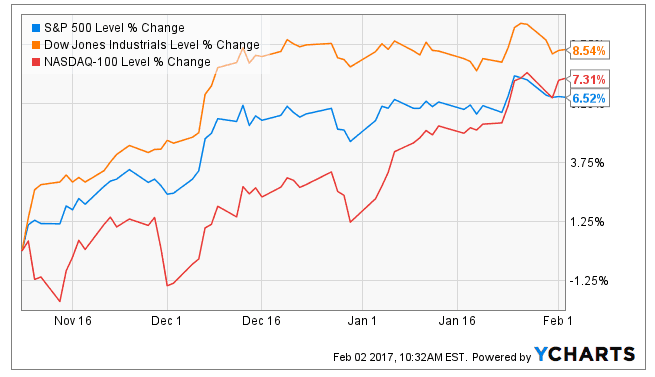
The President of the United States wields huge influence on the economic fate of the U.S. and the economic fate of the rest of the world to a large extent. The direct, vocal, unfiltered, and controversial nature of President Donald Trump also amplifies the influence of the POTUS of the economic and geopolitical fate of the world. Many Wall Street experts had predicted that the U.S. economy would be plunged into chaos if Trump becomes president.
The fears of increased uncertainties under Trump’s presidency have actually bolstered bullish forecasts for safe-haven assets such as gold. However, Trump’s surprise victory in the election didn’t trigger a market crash as expected. In fact, the broad U.S equities market has booked gains under Trump. This piece seeks to provide insight on what we can expect from the markets under president Trump going forward.
Interestingly, Trump’s words, actions, and inactions have been moving the U.S. financial markets massively since he won the election in Nov. 2016. For instance, since Trump’s victory at the election on Nov 8 2016, the S&P 500 has gained 6.52%, the NASDAQ is up 7.31%, and the Dow has crossed the 20,000 mark with 8.54% gains as shown in the chart below.
The effect of Trump’s presidency is also being felt in the Forex markets – the AMEX Dollar Index has gained more than 5% in the weeks after Trump’s victory but it currently sports 1.50% gains. Nonetheless, the dollar is seeing increased volatility because of lingering concerns about Trump’s move to restrict immigration from seven countries.
The effect of the change in American leadership is already becoming obvious in the U.S. labor market. The ADP Research Institute has reported that U.S. private employers added 246,000 jobs in January up from 151,000 in December 2016. Economists are also optimistic that job growth in the U.S. public sector will show a massive uptrend this year. Of course, one of the primary drivers of the incredible job growth is President Trump’s vocal stance on revitalizing the U.S. manufacturing and goods-production sectors.
Interestingly, there hasn’t been an increase in commodity trading prices in response to Trump’s presidency in sharp contrast to the expectations that Trump’s economic policies should naturally boost the prospects of commodities. For instance, the Bloomberg Commodity Index, which tracks the trend on future contracts on 22 commodity futures contracts, only booked a negligible 0.1% in January.
Of course, some individual commodities fared well than others. The gain is especially evident in industrial commodities such as copper, palladium, and lead in response to Trump’s plan for increased industrial spending. However, the gains in commodities still largely underperform the expectations of broad based gains in commodities such as gold. In fact, gold is down 7.60% since Trump’s victory on Nov 8.
It is still somewhat hard to finger President Trump as the only reason behind the mixed performance in the commodities sector because he has only been in office for two weeks after taking the oath of office on Jan 20. To start with, the commodities sector is still slowly recovering from a disheartening downturn. The energy sector has been down since 2015 after the supply glut in oil peaked and gold has not been shining bright since 2011. In essence, it was much harder for the commodities sector to book bigger gains under Trump because the sector was coming from a position of weakness.